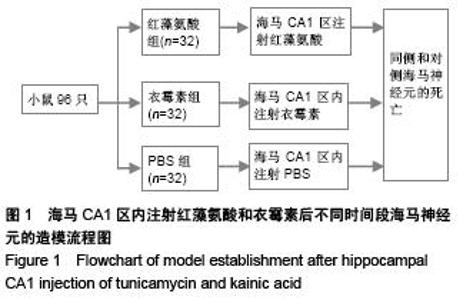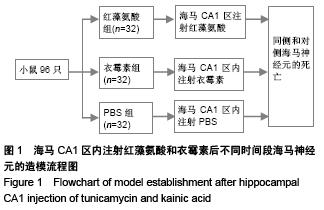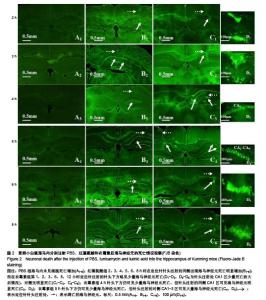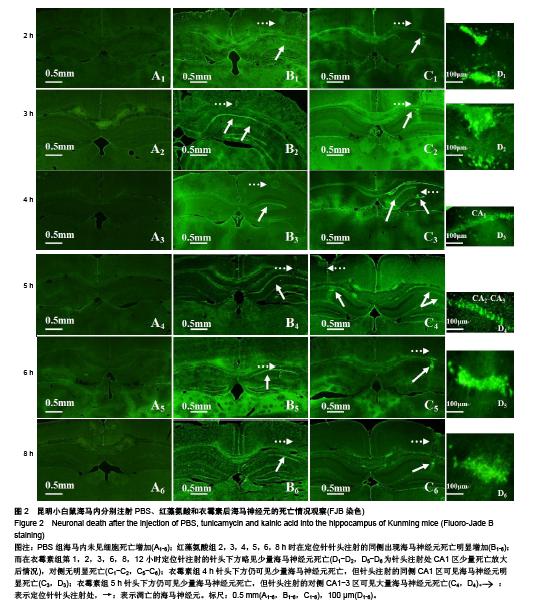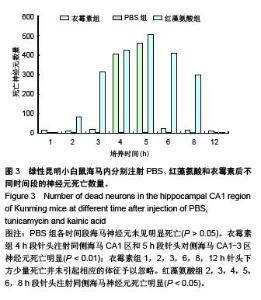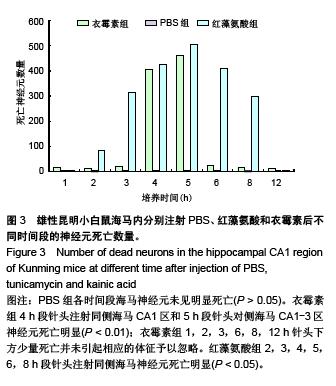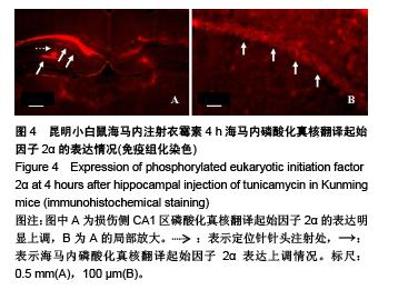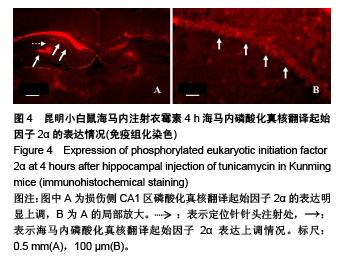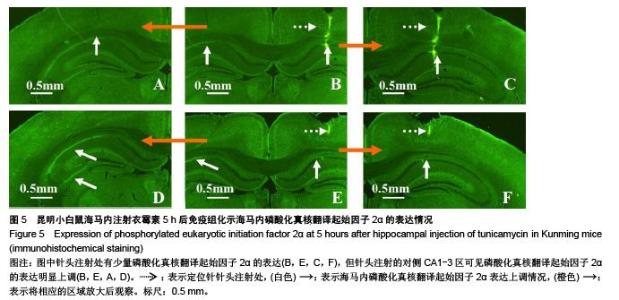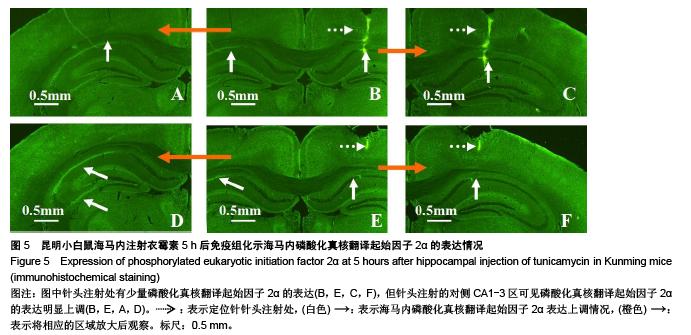Chinese Journal of Tissue Engineering Research ›› 2015, Vol. 19 ›› Issue (51): 8259-8265.doi: 10.3969/j.issn.2095-4344.2015.51.011
Previous Articles Next Articles
Tunicamycin-induced neuronal death in the hippocampus: new phenomenon and new hypothesis
- 1Hunan Provincial Key Laboratory of Human Anatomy and Histoembryology, Key Disciplines in Hunan Province, Changsha Medical University, Changsha 410219, Hunan Province, China; 2Department of Spine Surgery, Hunan Provincial People’s Hospital, Changsha 410005, Hunan Province, China; 3the Sixth People’s Hospital Affiliated to Shanghai Jiao Tong University, Shanghai 200233, China; 4Department of Cardiology, Hunan Provincial People’s Hospital, Changsha 410005, Hunan Province, China
-
Received:2015-10-24Online:2015-12-10Published:2015-12-10 -
Contact:Wu Chang-chu, Associate professor, Hunan Provincial Key Laboratory of Human Anatomy and Histoembryology, Key Disciplines in Hunan Province, Changsha Medical University, Changsha 410219, Hunan Province, China -
About author:Yuan Lei, Physician, Hunan Provincial Key Laboratory of Human Anatomy and Histoembryology, Key Disciplines in Hunan Province, Changsha Medical University, Changsha 410219, Hunan Province, China; Department of Spine Surgery, Hunan Provincial People's Hospital, Changsha 410005, Hunan Province, China -
Supported by:the National Natural Science Foundation of China, No. 81171136; Research Learning and Innovative Experiment Project of Undergraduates in Hunan Province, No. [2013]191-431, [2012]402-445; the Scientific Research Project of Higher Education in Hunan Province, No. 10A013; the Key Discipline Construction Project in Higher Education of Hunan Province during the Twelfth Five-Year Period, No. [2011]76
CLC Number:
Cite this article
Yuan Lei, Deng Si-min, Zhang Hai-xia, Qian Shi-lei, Xu Bin, Gong Ji-qin, Zeng Jie, Pan Juan. Tunicamycin-induced neuronal death in the hippocampus: new phenomenon and new hypothesis[J]. Chinese Journal of Tissue Engineering Research, 2015, 19(51): 8259-8265.
share this article
| [1] 袁磊,龚济钦,张海霞,等.KA1亚受体在内质网应激致海马神经元死亡中的作用[J].南方医科大学学报,2015,35(2):191-195.
[2] Luoma PV. Elimination of endoplasmic reticulum stress and cardiovascular, type 2 diabetic, and other metabolic diseases. Ann Med. 2013;45(2):194-202.
[3] Mihailidou C, Chatzistamou I, Papavassiliou AG, et al. Improvement of chemotherapeutic drug efficacy by endoplasmic reticulum stress. Endocr Relat Cancer. 2015; 22(2):229-238.
[4] Wang H, Wang X, Ke ZJ, et al. Tunicamycin-induced unfolded protein response in the developing mouse brain. Toxicol Appl Pharmacol. 2015;283(3):157-167.
[5] Imai T, Kosuge Y, Endo-Umeda K, et al. Protective effect of S-allyl-L-cysteine against endoplasmic reticulum stress-induced neuronal death is mediated by inhibition of calpain. Amino Acids. 2014;46(2):385-393.
[6] Carlisle RE, Brimble E, Werner KE, et al. 4-Phenylbutyrate inhibits tunicamycin-induced acute kidney injury via CHOP/GADD153 repression. PLoS One. 2014;9(1):e84663.
[7] Jiang H, Zou J, Zhang H, et al. Unfolded protein response inducers tunicamycin and dithiothreitol promote myeloma cell differentiation mediated by XBP-1. Clin Exp Med. 2015;15(1): 85-96.
[8] Cabral Miranda F, Adão-Novaes J, Hauswirth WW, et al. CHIP, a carboxy terminus HSP-70 interacting protein, prevents cell death induced by endoplasmic reticulum stress in the central nervous system. Front Cell Neurosci. 2015;8:438.
[9] 付政祺.GSK-3β介导了内质网应激诱导的tau蛋白过度磷酸化及大鼠空间记忆障碍[D].武汉:华中科技大学,2010.
[10] Ono Y, Tanaka H, Tsuruma K, et al. A sigma-1 receptor antagonist (NE-100) prevents tunicamycin-induced cell death via GRP78 induction in hippocampal cells. Biochem Biophys Res Commun. 2013;434(4):904-909.
[11] Ono Y, Shimazawa M, Ishisaka M, et al. Imipramine protects mouse hippocampus against tunicamycin-induced cell death. Eur J Pharmacol. 2012;696(1-3):83-88.
[12] 袁磊,张海霞,钱诗蕾,等.红藻氨酸诱导内质网应激模型的途径[J].中国组织工程研究,2014,18(36):5861-5867.
[13] 郭东华,刘湘华,曾杰,等.KA1表达再分布对神经元兴奋毒性的影响[J].中国组织工程研究,2012,16(2):287-290.
[14] Paxinos G, Franklin KB. The Mouse Brain in Stereotaxic Coordinates(Second Edition).New York: Academic Press, 2001:90-110.
[15] Bederson JB, Pitts LH, Tsuji M, et al. Rat middle cerebral artery occlusion: evaluation of the model and development of a neurologic examination. Stroke. 1986;17(3):472-476.
[16] Chen ZL, Yu H, Yu WM, et al. Proteolytic fragments of laminin promote excitotoxic neurodegeneration by up-regulation of the KA1 subunit of the kainate receptor. J Cell Biol. 2008; 183(7):1299-1313.
[17] 袁磊,龚济钦,张海霞,等.红藻氨酸受体与神经退行性变疾病相关性的研究进展[J].中国临床新医学,2014,7(4):367-371.
[18] 袁磊,徐斌,张海霞,等.以内质网应激浅谈糖尿病及其并发脑病的研究进展[J].解剖学研究,2014,36(5):380-384.
[19] Xia JG, Xu FF, Qu Y, et al. Atorvastatin post-conditioning attenuates myocardial ischemia reperfusion injury via inhibiting endoplasmic reticulum stress-related apoptosis. Shock. 2014;42(4):365-371.
[20] Solanki S, Dube PR, Tano JY, et al. Reduced endoplasmic reticulum stress-induced apoptosis and impaired unfolded protein response in TRPC3-deficient M1 macrophages. Am J Physiol Cell Physiol. 2014;307(6):C521-531.
[21] Schönthal AH. Pharmacological targeting of endoplasmic reticulum stress signaling in cancer. Biochem Pharmacol. 2013;85(5):653-666.
[22] Zhang R, Piao MJ, Kim KC, et al. Endoplasmic reticulum stress signaling is involved in silver nanoparticles-induced apoptosis. Int J Biochem Cell Biol. 2012;44(1):224-232.
[23] 高伟娜.孤核受体NR4A家族的表达与内质网应激的关系及其在胰岛β细胞中调控胰岛素基因表达的机制研究[D].济南:山东大学,2014.
[24] 马美娟,李妍,张英梅,等.不同程度内质网应激对巨噬细胞自噬的影响[J].现代生物医学进展,2014,14(2):209-213.
[25] Fu Z, Zou F, Deng H, et al. Estrogen protects SGC7901 cells from endoplasmic reticulum stress-induced apoptosis by the Akt pathway. Oncol Lett. 2014;7(2):560-564.
[26] Jiang L, Kon N, Li T, et al. Ferroptosis as a p53-mediated activity during tumour suppression. Nature. 2015;520(7545): 57-62.
[27] Wang Y, Feng ZY, Wang J, et al.Somatosensory stimulation suppresses the excitability of pyramidal cells in the hippocampal CA1 region in rats. Neural Regen Res. 2014;9 (11): 1138-1144 |
| [1] | Chen Ziyang, Pu Rui, Deng Shuang, Yuan Lingyan. Regulatory effect of exosomes on exercise-mediated insulin resistance diseases [J]. Chinese Journal of Tissue Engineering Research, 2021, 25(25): 4089-4094. |
| [2] | Chen Yang, Huang Denggao, Gao Yuanhui, Wang Shunlan, Cao Hui, Zheng Linlin, He Haowei, Luo Siqin, Xiao Jingchuan, Zhang Yingai, Zhang Shufang. Low-intensity pulsed ultrasound promotes the proliferation and adhesion of human adipose-derived mesenchymal stem cells [J]. Chinese Journal of Tissue Engineering Research, 2021, 25(25): 3949-3955. |
| [3] | Yang Junhui, Luo Jinli, Yuan Xiaoping. Effects of human growth hormone on proliferation and osteogenic differentiation of human periodontal ligament stem cells [J]. Chinese Journal of Tissue Engineering Research, 2021, 25(25): 3956-3961. |
| [4] | Sun Jianwei, Yang Xinming, Zhang Ying. Effect of montelukast combined with bone marrow mesenchymal stem cell transplantation on spinal cord injury in rat models [J]. Chinese Journal of Tissue Engineering Research, 2021, 25(25): 3962-3969. |
| [5] | Gao Shan, Huang Dongjing, Hong Haiman, Jia Jingqiao, Meng Fei. Comparison on the curative effect of human placenta-derived mesenchymal stem cells and induced islet-like cells in gestational diabetes mellitus rats [J]. Chinese Journal of Tissue Engineering Research, 2021, 25(25): 3981-3987. |
| [6] | Hao Xiaona, Zhang Yingjie, Li Yuyun, Xu Tao. Bone marrow mesenchymal stem cells overexpressing prolyl oligopeptidase on the repair of liver fibrosis in rat models [J]. Chinese Journal of Tissue Engineering Research, 2021, 25(25): 3988-3993. |
| [7] | Liu Jianyou, Jia Zhongwei, Niu Jiawei, Cao Xinjie, Zhang Dong, Wei Jie. A new method for measuring the anteversion angle of the femoral neck by constructing the three-dimensional digital model of the femur [J]. Chinese Journal of Tissue Engineering Research, 2021, 25(24): 3779-3783. |
| [8] | Meng Lingjie, Qian Hui, Sheng Xiaolei, Lu Jianfeng, Huang Jianping, Qi Liangang, Liu Zongbao. Application of three-dimensional printing technology combined with bone cement in minimally invasive treatment of the collapsed Sanders III type of calcaneal fractures [J]. Chinese Journal of Tissue Engineering Research, 2021, 25(24): 3784-3789. |
| [9] | Qian Xuankun, Huang Hefei, Wu Chengcong, Liu Keting, Ou Hua, Zhang Jinpeng, Ren Jing, Wan Jianshan. Computer-assisted navigation combined with minimally invasive transforaminal lumbar interbody fusion for lumbar spondylolisthesis [J]. Chinese Journal of Tissue Engineering Research, 2021, 25(24): 3790-3795. |
| [10] | Hu Jing, Xiang Yang, Ye Chuan, Han Ziji. Three-dimensional printing assisted screw placement and freehand pedicle screw fixation in the treatment of thoracolumbar fractures: 1-year follow-up [J]. Chinese Journal of Tissue Engineering Research, 2021, 25(24): 3804-3809. |
| [11] | Shu Qihang, Liao Yijia, Xue Jingbo, Yan Yiguo, Wang Cheng. Three-dimensional finite element analysis of a new three-dimensional printed porous fusion cage for cervical vertebra [J]. Chinese Journal of Tissue Engineering Research, 2021, 25(24): 3810-3815. |
| [12] | Wang Yihan, Li Yang, Zhang Ling, Zhang Rui, Xu Ruida, Han Xiaofeng, Cheng Guangqi, Wang Weil. Application of three-dimensional visualization technology for digital orthopedics in the reduction and fixation of intertrochanteric fracture [J]. Chinese Journal of Tissue Engineering Research, 2021, 25(24): 3816-3820. |
| [13] | Sun Maji, Wang Qiuan, Zhang Xingchen, Guo Chong, Yuan Feng, Guo Kaijin. Development and biomechanical analysis of a new anterior cervical pedicle screw fixation system [J]. Chinese Journal of Tissue Engineering Research, 2021, 25(24): 3821-3825. |
| [14] | Lin Wang, Wang Yingying, Guo Weizhong, Yuan Cuihua, Xu Shenggui, Zhang Shenshen, Lin Chengshou. Adopting expanded lateral approach to enhance the mechanical stability and knee function for treating posterolateral column fracture of tibial plateau [J]. Chinese Journal of Tissue Engineering Research, 2021, 25(24): 3826-3827. |
| [15] | Zhu Yun, Chen Yu, Qiu Hao, Liu Dun, Jin Guorong, Chen Shimou, Weng Zheng. Finite element analysis for treatment of osteoporotic femoral fracture with far cortical locking screw [J]. Chinese Journal of Tissue Engineering Research, 2021, 25(24): 3832-3837. |
| Viewed | ||||||
|
Full text |
|
|||||
|
Abstract |
|
|||||
